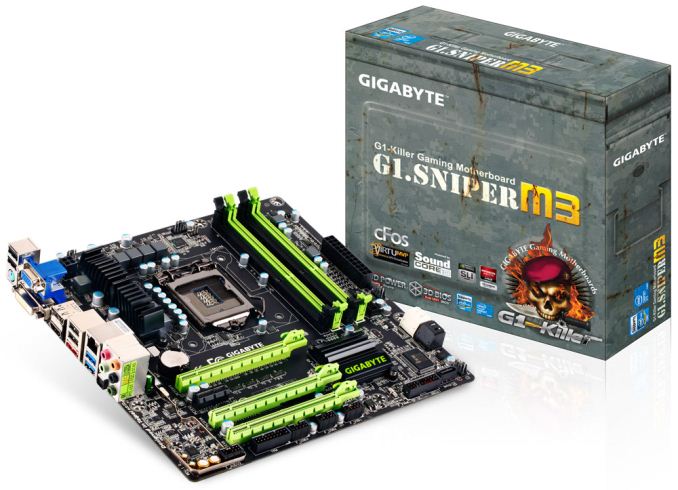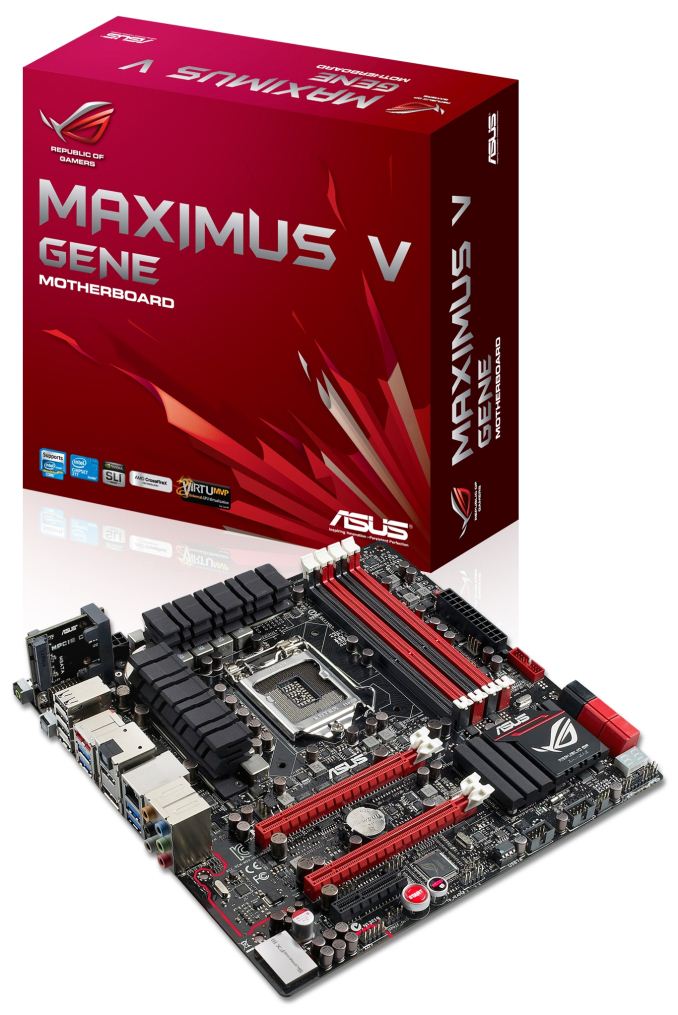ASUS Maximus V Gene vs. Gigabyte G1.Sniper M3 Review
by Ian Cutress on May 13, 2013 10:00 AM EST- Posted in
- Motherboards
- Gigabyte
- Asus
- MicroATX
- Z77
While we have not had many Z77 micro-ATX motherboards in to review this generation (something we will be remedying for Haswell), getting to grips with both the Maximus V Gene and the G1.Sniper M3 has been rather fun. Both of these boards would happily go into a slightly smaller gaming setup and still offer sufficient power when paired with the right cards – take a look at our recent review of multi-GPU gaming to see how a dual GPU setup might perform depending on which processor you may want to get.
Despite both motherboards aiming for roughly the same market, there is a difference between them in terms of which motherboard I would suggest people to buy.
Conclusion: Gigabyte G1.Sniper M3
On first glance, the Gigabyte G1.Sniper M3 looks like a good board – in terms of performance we are right on the money across the board, and overclocking performance is also competitive with the MVG. On the motherboard itself is a fairly default chipset arrangement, with five of the SATA ports in a 4+1 arrangement (+1 at right angles to the motherboard), 4 USB 3.0 total from the chipset and an x16 or x8/x8 arrangement for GPUs.
A couple of points do stand out however – the first is the audio. Onboard we have a Creative CA0132 codec solution, which promises a cleaner sound along with additional filtering and an EM shield to improve electrical noise. In our tests however, we had to disable all the additional software features in order to get RMAA to run – despite this it still performed well. Another point to stand out is the PCIe arrangement. On the face of the board, we have three green full length PCIe slots. Typically with a microATX board these are arranged in an x8/x1/x8/x4 arrangement, but on the G1.Sniper M3 these are x8/x1/x4/x8. This allows for two triple slot GPUs (probably a good thing), but unless you are paying attention then, like I did to begin with, cards may go in the x4 slot instead, which is powered by the chipset and offers bad scaling (that is in general across all motherboards). In this scenario CrossFireX does work, but SLI does not (you need x8 lanes per GPU). We tested the x16+x4 arrangement and clearly the x8/x8 is preferred. It is worth noting that using a second GPU like this will block one of the SATA ports.
Overall there are not that many extras on the G1.Sniper M3 – the MVG gives extra SATA ports, extra USB 3.0, along with a better fan controls and the software/BIOS package, all for $30 more. I think Gigabyte pushed the boat out trying to accommodate the Creative CA0132, but it has sort of backfired because other elements end up slightly lacking. If we had a Killer NIC onboard, as is the case on the G1.Sniper 3, it might be worth a look. But for $170-$180, this fits right into the range for the Z77X-UD5H or Z77X-UP4 TH, which I would rather go for, even though they are ATX.
Conclusion: ASUS Maximus V Gene
The Maximus V Gene provides a great motherboard with a ton of features, if you do not mind paying the small price premium. Even when you factor the initial cost in, against all the functionality, the software, the BIOS and the features, it makes financial sense that this board is worth purchasing for the extra green.
On the face of it, we get a high performing board with extra USB 3.0, extra SATA 6 Gbps, SupremeFX III audio, an mPCIe combo card, an Intel NIC, voltage read points, power/reset buttons, a two digit debug, excellent fan controls, and features like ROG Connect, FanXpert II, USB 3.0 Boost, GameFirst for network management and USB BIOS Flashback.
Performance wise the ASUS does quite well, enabling MCT and being very efficient across the board. With USB 3.0 Boost, our USB numbers while using this feature are enhanced by a good margin. Overclocking performed quite well, even with our bad CPU!
Any ASUS or ROG motherboard owner should hit up the ROG forums. If you are having issues, or want to push your hardware a little further, there are users and admins there to help.
As a combined package, the ASUS Maximus V Gene is well worth the money. At $200 it fits into that price range where most Z77 sales occur, albeit on full sized ATX boards. For example, at this price range we have the Gigabyte Z77X-UD5H, the MSI Z77 MPower, the ASUS P8Z77-I Deluxe, Gigabyte Z77X-UP4 TH, the ASRock Z77 OC Formula and the ASUS P8Z77-V Pro all as serious contenders, each with their own merits. But if you want an ROG board, the MVG is a great purchase.
In light of the performance and feature set, I would like to recommend the ASUS Maximus V Gene as a great purchase for those looking for a microATX Z77 motherboard.
Final Words
I know what some of you are thinking. Why bother reviewing two motherboards so close to the launch of Haswell? Surely users are going to want a Z87 motherboard instead? My response to this comes from different angles.
Firstly, Haswell adoption is not expected to be that high for the first few months. As noted in various press articles, the initial batches of Haswell have an issue with USB 3.0 devices being recognized after sleep/hibernation. Even before this issue was brought to light, DigiTimes reported that Haswell is likely to make up fewer than 20% of sales by year end.
Secondly, e-tailers and home users who want to upgrade from Ivy Bridge to Haswell will be selling their old motherboards and/or processors. There are a fair few users who stay slightly behind the curve in an effort to save money (this comic from xkcd springs to mind, but not as extreme as that), and users that are making the jump might sell en-mass just to get the newer models. Ivy Bridge is still relevant if you want a fast system – it may not be the newest in the next couple of months, but you don’t necessarily need the newest to get your work/gaming done.
Of course as a reviewer it is my job to review the cutting edge, but until the Haswell launch is here I cannot publish anything Haswell related. Nevertheless, our micro-ATX coverage for Haswell plans to be more extensive, so watch this space.













31 Comments
View All Comments
Ristogod - Monday, May 13, 2013 - link
The Title of the article indicates you are comparing the G1.Sniper 3. Instead you use the G1.Sniper M3 in the review.IanCutress - Monday, May 13, 2013 - link
Thanks :) I've had the Sniper 3 on the brain. Though several pairs of eyes have read through and all missed the title.Ian
A5 - Monday, May 13, 2013 - link
I wish manufacturers were more willing to send you cheaper mATX boards.Neither of these boards really feel like a good value compared to cheaper things in the same companies' lines. I guess the ROG makes some sense if you really need the wi-fi card + SLI/XFire (which loses you the Intel NIC as a useful feature...), but still.
IanCutress - Monday, May 13, 2013 - link
It is something I am changing with Haswell. After initial launch reviews, I want to look at mATX. I've let the manufacturers know. That means gaming models and the cheaper end of the spectrum, perhaps in a couple of roundups focusing on price points or individually if people prefer the reviews that way.Ian
A5 - Monday, May 13, 2013 - link
I personally like round-ups better due to the fact that they make the writer make explicit comparisons, but I understand that they're way more work for you :PEither way I'll probably upgrade before it would be published, but I appreciate the idea of increasing coverage in that segment.
DanNeely - Monday, May 13, 2013 - link
I'm probably going to hold off until the USB3 fix refresh is out; so I should be able to read all the initial wave reviews before opening my wallet. My main box is going to be high OCed and water cooled; so I assume the boards I'm interested in will be in the initial flagship/near flagship review wave.MrSpadge - Tuesday, May 14, 2013 - link
Agreed - at these prices I wouldn't consider such mainboards at all.just4U - Tuesday, May 14, 2013 - link
A5, I don't see them as a good value compared to cheaper boards in the same company. My view has always been (with gaming matx) they are a great value when compared to more expensive boards in the same company. They pack a lot into these little boards /w features typically only seen in their highest end offerings.GeorgeH - Monday, May 13, 2013 - link
I had the Gene for about a week before replacing it. It was an awesome board, I just couldn't stand the coil whine. Sample size of 1, though, so did you notice any whine with your review sample?IanCutress - Monday, May 13, 2013 - link
No coil whine on my sample. I notice that some motherboards cause my testing PSUs to whine every now and again, especially in multi-GPU setups on gaming tests, but I can't say I had any with the Gene.Ian